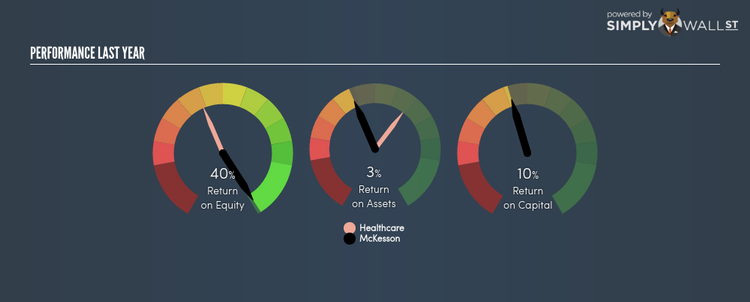How Did McKesson Corporation’s (NYSE:MCK) 39.56% ROE Fare Against The Industry?

McKesson Corporation (NYSE:MCK) delivered an ROE of 39.56% over the past 12 months, which is an impressive feat relative to its industry average of 12.29% during the same period. Superficially, this looks great since we know that MCK has generated big profits with little equity capital; however, ROE doesn’t tell us how much MCK has borrowed in debt. We’ll take a closer look today at factors like financial leverage to determine whether MCK’s ROE is actually sustainable. Check out our latest analysis for McKesson
Peeling the layers of ROE – trisecting a company’s profitability
Return on Equity (ROE) weighs McKesson’s profit against the level of its shareholders’ equity. For example, if the company invests $1 in the form of equity, it will generate $0.4 in earnings from this. While a higher ROE is preferred in most cases, there are several other factors we should consider before drawing any conclusions.
Return on Equity = Net Profit ÷ Shareholders Equity
ROE is assessed against cost of equity, which is measured using the Capital Asset Pricing Model (CAPM) – but let’s not dive into the details of that today. For now, let’s just look at the cost of equity number for McKesson, which is 8.49%. Since McKesson’s return covers its cost in excess of 31.07%, its use of equity capital is efficient and likely to be sustainable. Simply put, McKesson pays less for its capital than what it generates in return. ROE can be broken down into three different ratios: net profit margin, asset turnover, and financial leverage. This is called the Dupont Formula:
Dupont Formula
ROE = profit margin × asset turnover × financial leverage
ROE = (annual net profit ÷ sales) × (sales ÷ assets) × (assets ÷ shareholders’ equity)
ROE = annual net profit ÷ shareholders’ equity
Basically, profit margin measures how much of revenue trickles down into earnings which illustrates how efficient the business is with its cost management. Asset turnover reveals how much revenue can be generated from McKesson’s asset base. The most interesting ratio, and reflective of sustainability of its ROE, is financial leverage. Since financial leverage can artificially inflate ROE, we need to look at how much debt McKesson currently has. Currently the debt-to-equity ratio stands at a reasonable 66.12%, which means its above-average ROE is driven by its ability to grow its profit without a significant debt burden.
What this means for you:
Are you a shareholder? MCK’s ROE is impressive relative to the industry average and also covers its cost of equity. Since its high ROE is not likely driven by high debt, it might be a good time to top up on your current holdings if your fundamental research reaffirms this analysis. If you’re looking for new ideas for high-returning stocks, you should take a look at our free platform to see the list of stocks with Return on Equity over 20%.
Are you a potential investor? If you are considering investing in MCK, looking at ROE on its own is not enough to make a well-informed decision. I recommend you do additional fundamental analysis by looking through our most recent infographic report on McKesson to help you make a more informed investment decision.
To help readers see pass the short term volatility of the financial market, we aim to bring you a long-term focused research analysis purely driven by fundamental data. Note that our analysis does not factor in the latest price sensitive company announcements.
The author is an independent contributor and at the time of publication had no position in the stocks mentioned.


